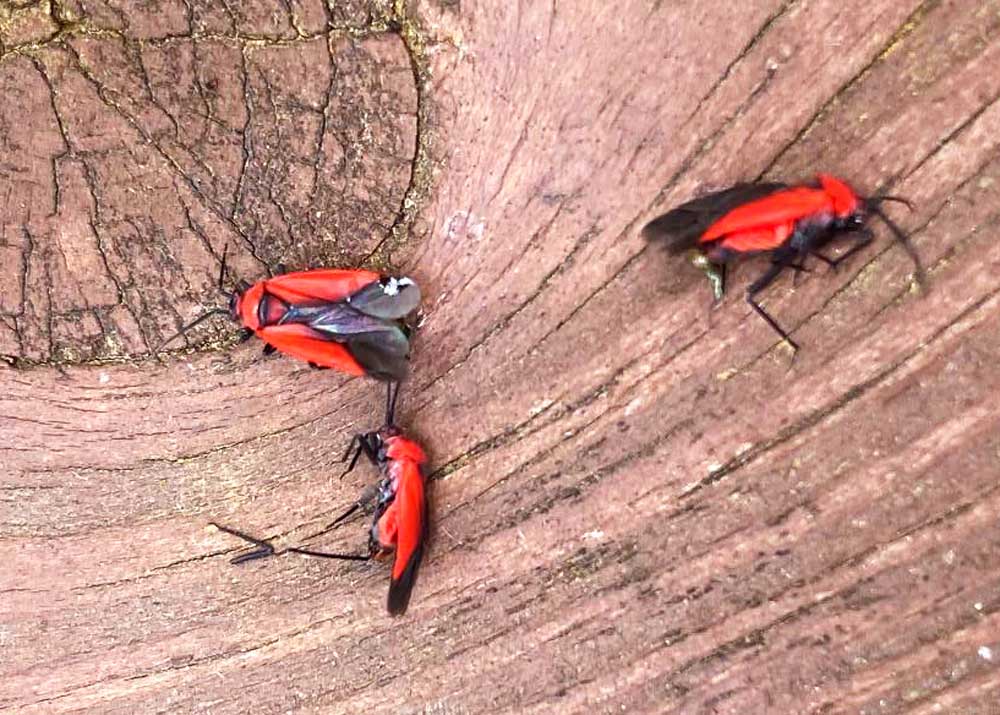A reader gets these black and red bugs every spring. What are they? Sperry weighs in.
Published 5:00 am Saturday, May 11, 2024

- These are red mountain laurel mirids. (Contributed Photo)
Dear Neil: We get these red and black bugs on the new growth of our Texas mountain laurels each spring. What are they, and how can we eliminate them?
These are red mountain laurel mirids (Lopidea major). Texas AgriLife Extension Program Specialist and entomologist Wizzie Brown says their piercing/sucking feeding can disfigure new growth, but it will seldom lead to long-term damage. General-purpose contact insecticides should control them if you feel the need.
Trending
Dear Neil: I heard a recommendation to mow my lawn at 3 inches the other day as a means of conserving water. Is that good advice? I have bermuda grass.
I vote a big “No!” Common bermuda should be mowed at 1 to 1-1/2 inches. To let it grow to 3 inches would cause it to become lanky and weak. The next thing you would see is weed invasion. It is much better to mow it at the recommended height, but to cut back on the frequency of watering and water more deeply when you do water. That will encourage deeper root penetration, and that is good for the long-term vigor of the turf. “Smart” controllers are good ways of saving water. We also need to make sure that our hoses, sprinklers, valves, and fittings are all in perfect working condition. Those are more important means of conserving water than raising the mower height.
Dear Neil: I have a small magnolia tree in our front yard. It has recently turned brown. I wonder if it has died or if it might come back. I put a liquid fertilizer and iodine on it, but I can’t tell yet. Do you have any suggestions?
I suspect you put Ironite and not iodine on your tree. At least, I certainly hope so. It’s possible your tree got too dry in last summer’s and fall’s extended drought. I would suggest keeping its soil very moist for the next couple of months. Don’t worry about feeding it. You need to see if the branches have any life left in them. The tree may even send up new shoots from its base. One of those could be trained as its new trunk. Without seeing a photo, that my best guess.
Dear Neil: Several days ago, our neighbor’s oak tree was struck by lightning. We noticed a burn mark down the side of the trunk and the soil at the ground line was very much disturbed. In the past few days, we have noticed many more burn lines. Do you think the tree can survive?
That’s pretty major damage. I would suggest getting an International Society of Arboriculture (ISA) Certified Arborist on site to evaluate the tree. He or she will be able to determine the depth of any splitting, for example. I hope it can be saved. Do not start carving and peeling the bark on your own. Leave this one to the pros.
Trending
Dear Neil: I have several iris plants (not bearded iris, but types with long leaves) that produce lovely foliage, but they don’t bloom. What can I do to get flowers?
They may need more light. While most Louisiana iris (and others of the many numbers of types of iris) will tolerate a good bit of shade and still bloom, flowering will be best if they get sun at least three-fourths of the day. If they’ve been where they are for many years, you might try digging and spacing them to lessen the crowding. Don’t trim their foliage unless it’s brown.
Dear Neil: Where in Texas can bougainvilleas be planted outdoors and have a good chance of surviving the winter?
Bougainvilleas can be damaged by more than just freezing weather. They’re not too happy with temperatures below 45, especially for prolonged periods. However, to answer your question, anywhere along the Gulf Coast, including warmer spots in Houston, San Antonio and southward. In the borderline areas where they’re marginally hardy, they’ll make it through some winters, but not others. Containers are always safe, as long as you have room for them inside or in a greenhouse. They get quite large as they age.
Dear Neil: How should I handle my lamb’s ear once it finishes flowering? Do I cut it back to encourage new growth or just leave it alone?
You really don’t want lamb’s ear to flower at all. The blooms aren’t especially pretty, and they really drag the plants’ natural vigor down in the process. Snap them off as soon as you see the bud stalks, just as you do for coleus and caladiums.
Dear Neil: Our live oak has been covered with little balls stuck on every limb. What are these, and what can we do?
Oaks are subject to hundreds of types of galls. They are caused by insects that sting the plants’ tissues as they deposit their eggs. The good news is that they’re harmless. The bad news is, there is no chemical control for them. You have what is called woody oak galls on your live oak. They are the result of wasp-like insects that swarm around the trees at certain times of the year. Curiously, not all live oaks are bothered by them. Other types of galls that you will see are large, puffy green galls on red oaks and wooly, small balls on the backs of your live oak leaves.






